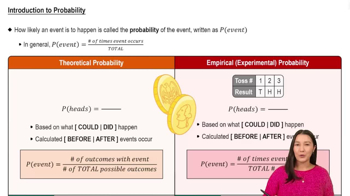When drawing a marble out of a bag of red, green, and yellow marbles 8 times, a red or yellow marble is drawn 6 times. What is the probability of drawing a green marble?
Table of contents
- 1. Intro to Stats and Collecting Data1h 14m
- 2. Describing Data with Tables and Graphs1h 55m
- 3. Describing Data Numerically2h 5m
- 4. Probability2h 16m
- 5. Binomial Distribution & Discrete Random Variables3h 6m
- 6. Normal Distribution and Continuous Random Variables2h 11m
- 7. Sampling Distributions & Confidence Intervals: Mean3h 23m
- Sampling Distribution of the Sample Mean and Central Limit Theorem19m
- Distribution of Sample Mean - Excel23m
- Introduction to Confidence Intervals15m
- Confidence Intervals for Population Mean1h 18m
- Determining the Minimum Sample Size Required12m
- Finding Probabilities and T Critical Values - Excel28m
- Confidence Intervals for Population Means - Excel25m
- 8. Sampling Distributions & Confidence Intervals: Proportion1h 12m
- 9. Hypothesis Testing for One Sample3h 29m
- 10. Hypothesis Testing for Two Samples4h 50m
- Two Proportions1h 13m
- Two Proportions Hypothesis Test - Excel28m
- Two Means - Unknown, Unequal Variance1h 3m
- Two Means - Unknown Variances Hypothesis Test - Excel12m
- Two Means - Unknown, Equal Variance15m
- Two Means - Unknown, Equal Variances Hypothesis Test - Excel9m
- Two Means - Known Variance12m
- Two Means - Sigma Known Hypothesis Test - Excel21m
- Two Means - Matched Pairs (Dependent Samples)42m
- Matched Pairs Hypothesis Test - Excel12m
- 11. Correlation1h 6m
- 12. Regression1h 50m
- 13. Chi-Square Tests & Goodness of Fit1h 57m
- 14. ANOVA1h 57m
4. Probability
Complements
Problem 4.2.1
Textbook Question
Notation When randomly selecting a new smartphone, D denotes the event that it has a manufacturing defect. What do P(D) and P(D) represent?
 Verified step by step guidance
Verified step by step guidance1
Step 1: Understand the notation. In probability, 'P(D)' represents the probability of event 'D' occurring. Here, 'D' is the event that a randomly selected smartphone has a manufacturing defect.
Step 2: Clarify the meaning of 'P(D)'. It quantifies the likelihood of the event 'D' happening, expressed as a value between 0 and 1, where 0 means the event is impossible and 1 means the event is certain.
Step 3: Recognize that 'P(D)' is a mathematical representation of the probability. For example, if 5% of smartphones have defects, then P(D) = 0.05.
Step 4: If the problem also refers to 'P(D)', it is likely asking for the same probability value, as 'P(D)' is the standard notation for the probability of event 'D'.
Step 5: To calculate P(D) in practice, you would divide the number of defective smartphones by the total number of smartphones in the sample or population, using the formula: .
 Verified video answer for a similar problem:
Verified video answer for a similar problem:This video solution was recommended by our tutors as helpful for the problem above
Video duration:
2mPlay a video:
Was this helpful?
Key Concepts
Here are the essential concepts you must grasp in order to answer the question correctly.
Probability
Probability is a measure of the likelihood that a particular event will occur, expressed as a number between 0 and 1. In this context, P(D) represents the probability that a randomly selected smartphone has a manufacturing defect. Understanding probability is essential for interpreting the likelihood of events in statistics.
Recommended video:

Introduction to Probability
Event
An event in probability is a specific outcome or a set of outcomes from a random experiment. In this case, D is the event that a smartphone has a manufacturing defect. Recognizing events helps in calculating probabilities and understanding the context of statistical analysis.
Recommended video:

Probability of Multiple Independent Events
Notation in Probability
Notation in probability provides a standardized way to represent events and their probabilities. P(D) specifically denotes the probability of event D occurring. Familiarity with this notation is crucial for effectively communicating and solving problems in statistics.
Recommended video:

Introduction to Probability

 4:23m
4:23mWatch next
Master Complementary Events with a bite sized video explanation from Patrick
Start learningRelated Videos
Related Practice
Multiple Choice
